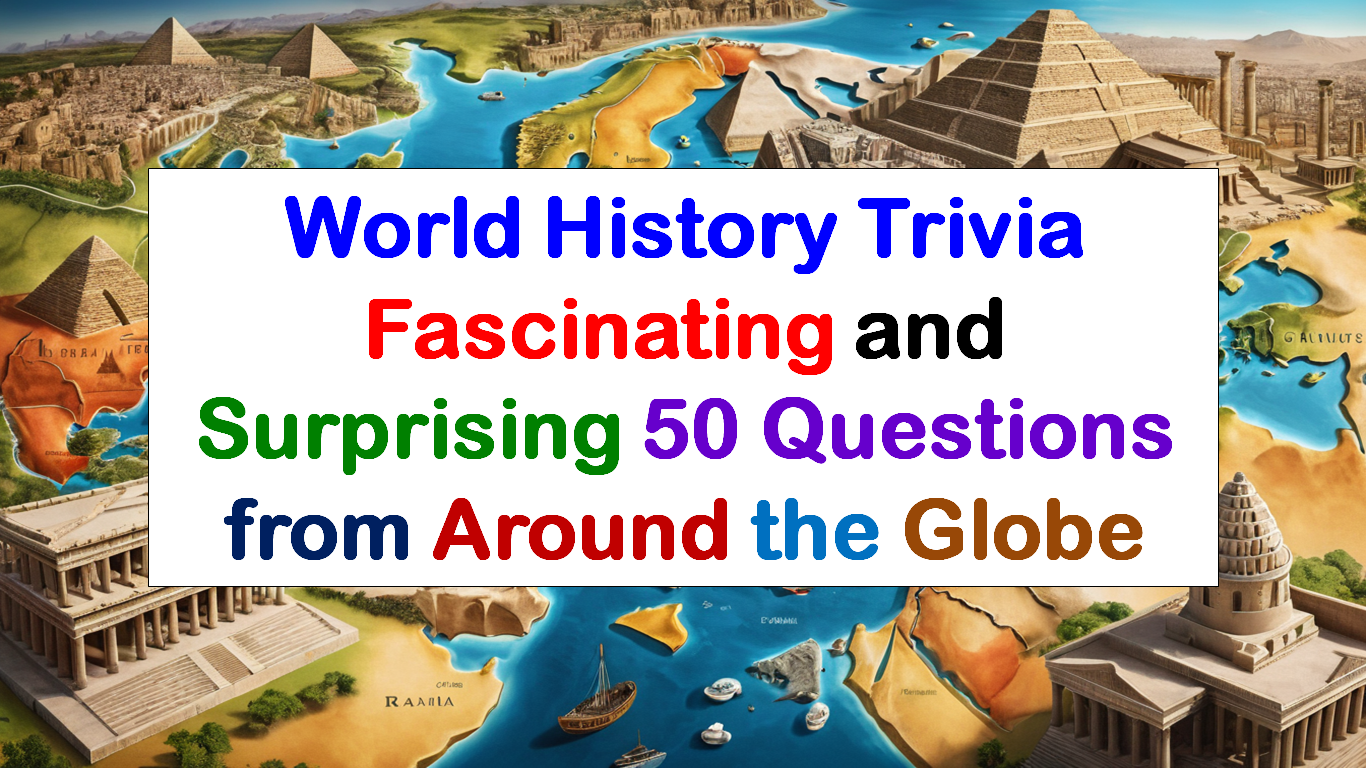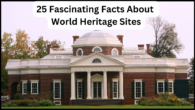
World History Trivia: Fascinating and Surprising 50 Questions from Around the Globe
Hello Friends!
Discover interesting and surprising fun facts about world history Trivia! Discover fun facts about ancient civilizations, famous historical figures, and major events that shaped our world. Perfect for history buffs and curious minds!”
World history is a treasure trove of fascinating events, powerful leaders, and groundbreaking discoveries that have shaped our world. From ancient civilizations like Egypt and Rome to pivotal moments like World War I, there are endless stories to discover in history. But diving into history doesn’t always have to mean reading a textbook – trivia is a fun and engaging way to learn about the past! Through trivia, we can discover surprising information about famous events, influential figures, and quirky, lesser-known facts from different time periods. Whether you’re a history buff or simply curious, trivia brings history to life in an entertaining and interactive way, making learning both fun and informative.
World History Trivia: Ancient Civilizations: Egypt, Greece, Rome, Mesopotamia
- In ancient Egypt, who was considered the god of the underworld?
(A) Ra
(B) Anubis
(C) Osiris
(D) Horus
Answer: (C) Osiris
- Which of the following was the primary writing system used by the Mesopotamians?
(A) Hieroglyphics
(B) Cuneiform
(C) Sanskrit
(D) Latin
Answer: (B) Cuneiform
- The first recorded Olympic Games were held in which ancient Greek city?
(A) Athens
(B) Corinth
(C) Sparta
(D) Olympia
Answer: (D) Olympia
- In ancient Rome, which structure was built for gladiatorial contests and public spectacles?
(A) The Parthenon
(B) The Pantheon
(C) The Colosseum
(D) Circus Maximus
Answer: (C) The Colosseum
- Which of the following was the primary function of the ziggurat in ancient Mesopotamia?
(A) Palaces for the kings
(B) Fortresses for protection
(C) Temples for religious worship
(D) Schools for scribes
Answer: (C) Temples for religious worship
- Who was the famous Egyptian queen known for her alliance with Julius Caesar and Mark Antony?
(A) Nefertiti
(B) Cleopatra VII
(C) Hatshepsut
(D) Ankhesenamun
Answer: (B) Cleopatra VII
- What was the main food crop that supported ancient Mesopotamian civilizations?
(A) Corn
(B) Barley
(C) Rice
(D) Wheat
Answer: (B) Barley
- In ancient Greece, which philosopher was the student of Plato and the teacher of Alexander the Great?
(A) Socrates
(B) Aristotle
(C) Pythagoras
(D) Herodotus
Answer: (B) Aristotle
- The Roman Empire famously built roads that connected its vast territories. What phrase is used to describe their importance?
(A) All roads lead to Rome
(B) The roads to victory
(C) Roman highways of trade
(D) The roads of the republic
Answer: (A) All roads lead to Rome
- The ancient city of Babylon, known for its Hanging Gardens, was part of which ancient civilization?
(A) Greek
(B) Egyptian
(C) Mesopotamian
(D) Roman
Answer: (C) Mesopotamian
World History Trivia:Medieval History: Kings, Castles, Crusades
- Who became the first Norman king of England after the Battle of Hastings fought in 1066?
(A) Richard the Lionheart
(B) Henry II
(C) William the Conqueror
(D) Edward I
Answer: (C) William the Conqueror
- Which famous medieval king led the Third Crusade against Saladin?
(A) Philip II of France
(B) Richard I of England
(C) Frederick Barbarossa
(D) Louis IX of France
Answer: (B) Richard I of England
- What was the primary purpose of castles in medieval times?
(A) Residential palaces for royalty
(B) Centers of religious worship
(C) Defensive fortifications and protection
(D) Trading hubs
Answer: (C) Defensive fortifications and protection
- Which English king’s powers were limited after the signing of the Magna Carta in 1215?
(A) King John
(B) King Edward III
(C) King Henry VIII
(D) King Stephen
Answer: (A) King John
- Which military order of knights was founded during the Crusades to protect Christian pilgrims traveling to the Holy Land?
(A) The Knights Templar
(B) The Teutonic Knights
(C) The Hospitallers
(D) The Knights of Malta
Answer: (A) The Knights Templar
- Between which two countries was the Hundred Years’ War fought mainly?
(A) England and France
(B) Spain and Portugal
(C) Germany and Italy
(D) Scotland and Norway
Answer: (A) England and France
- What was the main defensive feature of a medieval castle’s entrance?
(A) Drawbridge
(B) Moat
(C) Portcullis
(D) Watchtower
Answer: (C) Portcullis
- Which medieval monarch is associated with the unification of Spain through marriage to Isabella I of Castile?
(A) Charles V
(B) Ferdinand II of Aragon
(C) Alfonso VIII
(D) Philip II
Answer: (B) Ferdinand II of Aragon
- What was the outcome of the First Crusade?
(A) The capture of Jerusalem by Christian forces
(B) The complete expulsion of Muslims from Spain
(C) The defeat of Christian forces at the Battle of Hattin
(D) The sack of Constantinople by Crusaders
Answer: ( A) The capture of Jerusalem by Christian forces
- Which famous fortress was the residence of French kings until the late 14th century?
(A) Windsor Castle
(B) The Tower of London
(C) Château de Versailles
(D) The Louvre
Answer: (D) The Louvre
World History Trivia: Age of Exploration
- Who was the first European explorer to reach India by sea, opening the maritime route from Europe to Asia?
(A) Christopher Columbus
(B) Vasco da Gama
(C) Ferdinand Magellan
(D) Bartolomeu Dias
Answer: (B) Vasco da Gama
- Which explorer is credited with the first circumnavigation of the globe, though he did not survive the entire journey?
(A) Ferdinand Magellan
(B) Sir Francis Drake
(C) Amerigo Vespucci
(D) Hernán Cortés
Answer: (A) Ferdinand Magellan
- Who was the Italian explorer who traveled under the Spanish flag and is credited with the “discovery” of America in 1492?
(A) Amerigo Vespucci
(B) Christopher Columbus
(C) Marco Polo
(D) Leif Erikson
Answer: (B) Christopher Columbus
- Which Portuguese explorer was the first European to round the southern tip of Africa, later named the Cape of Good Hope?
(A) Vasco Núñez de Balboa
(B) Hernando de Soto
(C) Bartolomeu Dias
(D) Henry the Navigator
Answer: (C) Bartolomeu Dias
- The expedition of which Spanish explorer led to the fall of the Aztec Empire in Mexico?
(A) Francisco Pizarro
(B) Hernán Cortés
(C) Pedro Álvares Cabral
(D) Juan Ponce de León
Answer: (B) Hernán Cortés
- What was the name of the first ship to successfully circumnavigate the globe?
(A) Santa Maria
(B) The Mayflower
(C) Victoria
(D) Golden Hind
Answer: (C) Victoria
- Who was the first European to see the Pacific Ocean after crossing the Isthmus of Panama in 1513?
(A) Vasco Núñez de Balboa
(B) Francisco Pizarro
(C) Hernando de Soto
(D) Giovanni da Verrazzano
Answer: (A) Vasco Núñez de Balboa
- Which English explorer is known for his voyages to the New World and for playing a key role in the establishment of the Roanoke Colony?
(A) John Cabot
(B) Sir Walter Raleigh
(C) Sir Francis Drake
(D) Henry Hudson
Answer: (B) Sir Walter Raleigh
- Which explorer’s travels to the Far East in the 13th century inspired later European explorers like Columbus and Magellan?
(A) Ibn Battuta
(B) Marco Polo
(C) Zheng He
(D) Henry the Navigator
Answer: (B) Marco Polo
- Which Dutch explorer is credited with discovering New Zealand and parts of Australia in the 17th century?
(A) Abel Tasman
(B) James Cook
(C) Willem Janszoon
(D) Dirk Hartog
Answer: (A) Abel Tasman
World History Trivia: Revolutions and Wars
- Which event is widely regarded as the start of the American Revolutionary War?
(A) Battle of Yorktown
(B) Boston Tea Party
(C) Battle of Lexington and Concord
(D) Signing of the Declaration of Independence
Answer: (C) Battle of Lexington and Concord
- Which queen is often credited with the famous phrase “Let them eat cake” during the French Revolution?
(A) Catherine de’ Medici
(B) Marie Antoinette
(C) Anne of Austria
(D) Charlotte Corday
Answer: (B) Marie Antoinette
- Which treaty ended the American Revolutionary War and recognized the independence of the United States?
(A) Treaty of Versailles
(B) Treaty of Ghent
(C) Treaty of Paris
(D) Treaty of Utrecht
Answer: (C) Treaty of Paris
- What year did the French Revolution begin?
(A) 1789
(B) 1776
(C) 1815
(D) 1793
Answer: (A) 1789
- Which battle is considered the turning point in the Pacific Theater during World War II?
(A) Battle of the Coral Sea
(B) Battle of Midway
(C) Battle of Guadalcanal
(D) Battle of Iwo Jima
Answer: (B) Battle of Midway
- Who was the leader of the Bolsheviks when the Russian Revolution of 1917 occurred?
(A) Joseph Stalin
(B) Leon Trotsky
(C) Vladimir Lenin
(D) Nicholas II
Answer: (C) Vladimir Lenin
- The fall of which French fortress marked a major turning point in World War I, leading to the end of the war?
(A) Bastille
(B) Somme
(C) Verdun
(D) Fort Douaumont
Answer: (C) Verdun
- What was the main cause of the outbreak of World War I in 1914?
(A) The Russian Revolution
(B) Archduke Franz Ferdinand’s assassination
(C) To signing of the Treaty of Versailles
(D) The invasion of Poland
Answer: (B) Archduke Franz Ferdinand’s assassination
- The storming of which prison symbolized the start of the French Revolution?
(A) The Bastille
(B) The Louvre
(C) Château de Vincennes
(D) Tuileries Palace
Answer: (A) The Bastille
- Which of the following events directly led the United States to enter World War II?
(A) The invasion of Poland
(B) The bombing of Pearl Harbor
(C) The D-Day landings
(D) The Battle of Britain
Answer: (B) The bombing of Pearl Harbor
World History Trivia: Famous Historical Figures
- Who was the first emperor of Rome, establishing the Roman Empire after the fall of the Roman Republic?
(A) Julius Caesar
(B) Augustus
(C) Nero
(D) Marcus Aurelius
Answer: (B) Augustus
- Which political leader is famous for his “I Have a Dream” speech during the American Civil Rights Movement?
(A) Malcolm X
(B) Frederick Douglass
(C) Martin Luther King Jr.
(D) Rosa Parks
Answer: (C) Martin Luther King Jr.
- Who led the Mongol Empire to its largest territorial expansion in the 13th century?
(A) Kublai Khan
(B) Genghis Khan
(C) Timur
(D) Batu Khan
Answer: (B) Genghis Khan
- Who was the British prime minister during World War II, famous for his speeches and leadership?
(A) Neville Chamberlain
(B) Clement Attlee
(C) Winston Churchill
(D) Harold Macmillan
Answer: (C) Winston Churchill
- Who was the first woman to win a Nobel Prize and is known for her pioneering work in radioactivity?
(A) Marie Curie
(B) Ada Lovelace
(C) Rosalind Franklin
(D) Jane Goodall
Answer: (A) Marie Curie
- Which Egyptian queen is known for her relationships with Julius Caesar and Mark Antony, and her tragic demise?
(A) Hatshepsut
(B) Cleopatra VII
(C) Nefertiti
(D) Sobekneferu
Answer: (B) Cleopatra VII
- Who was the South African leader who became the country’s first black president after leading the fight against apartheid?
(A) Nelson Mandela
(B) Desmond Tutu
(C) Thabo Mbeki
(D) Steve Biko
Answer: (A) Nelson Mandela
- Who among the following French military leaders rose to prominence during the French Revolution and later became the Emperor of France?
(A) Louis XIV
(B) Charles de Gaulle
(C) Napoleon Bonaparte
(D) Maximilien Robespierre
Answer: (C) Napoleon Bonaparte
- Who was the Indian leader that advocated for nonviolent resistance and played a key role in India’s independence from British rule?
(A) Jawaharlal Nehru
(B) Subhas Chandra Bose
(C) Mohandas Gandhi
(D) Bhagat Singh
Answer: (C) Mohandas Gandhi
- Who was the famous British naturalist known for his theory of evolution by natural selection?
(A) Isaac Newton
(B) Charles Darwin
(C) Gregor Mendel
(D) Alfred Russel Wallace
Answer: (B) Charles Darwin
History isn’t just about dates and events – it’s about the incredible stories behind them. Trivia is a great way to dive into world history and uncover surprising truths about the past. So the next time you want to impress your friends or just learn something new, try some world history trivia questions!





Leave a Reply